#atari video computer system
Text

USA 1990
#USA1990#VIDEO GAMES & COMPUTER ENTERTAINMENT#BOOKS#AMIGA#ATARIst#IBM#C64#MACINTOSH#SEGA GENESIS#TURBOGRAFX#NES#SEGA MASTER SYSTEM#GAMEBOY#ATARI LYNX
30 notes
·
View notes
Photo

Atari ST Box Art Wallpaper: Ultima V: Warriors of Destiny by Aurelien Vaillant aka Wasabim
#Atari#Atari ST#Origin Systems#Ultima#Ultima V: Warriors of Destiny#wallpaper#graphic design#video games#retro gaming#retro computing#Wasabim#Aurelien Vaillant
11 notes
·
View notes
Photo

MY BELATED BIRTHDAY GIFTS HAVE ARRIVED!!! 😊😍🥳🎉🎁 #LEGO #TECHNIC #AIRBUSH175 #RESCUEHELICOPTER #HELICOPTER #ATARI #ATARI2600 #VIDEO #COMPUTER #SYSTEM #CENTIPEDE #ADVENTURE #ASTEROIDS #80SNOSTALGIA https://www.instagram.com/p/ChQZqBGJ6JQ/?igshid=NGJjMDIxMWI=
#lego#technic#airbush175#rescuehelicopter#helicopter#atari#atari2600#video#computer#system#centipede#adventure#asteroids#80snostalgia
0 notes
Text

Atari XEGS video game system at the Evercon Side Quest event in Rothschild Wisconsin last month. The Atari XEGS was the last Atari 8-bit computer, stylized as a video game machine. The idea was that between this system and the then-new Atari 7800 and their glut of legacy software support, they could reassert Atari into the video game market Nintendo had taken over in the late 1980's. It didn't work, though not because the machines weren't any good.
The game here is "Return of the Jedi" which in this level has the player pilot the Millennium Falcon at the battle of Endor.
#Atari#Atari XEGS#XEGS#Evercon#Atari 7800#Atari Computer#Wisconsin Computer Club#Vintage Computer#Vintage Gaming#Retro Gaming
170 notes
·
View notes
Text
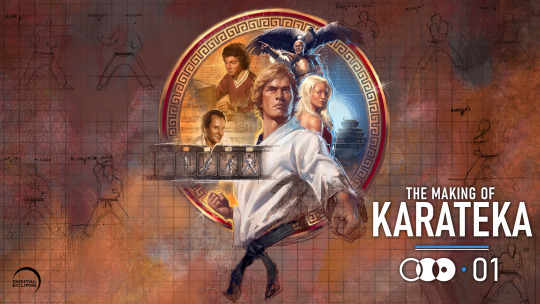
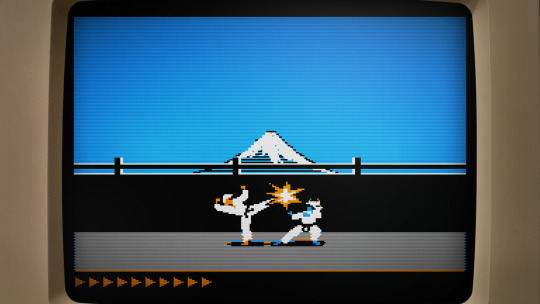
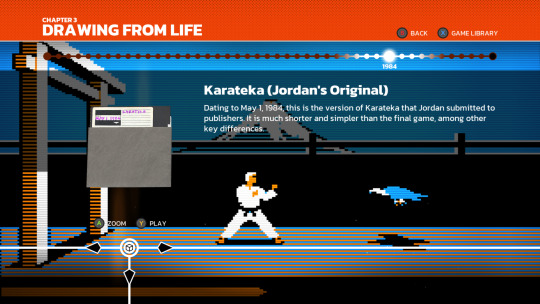


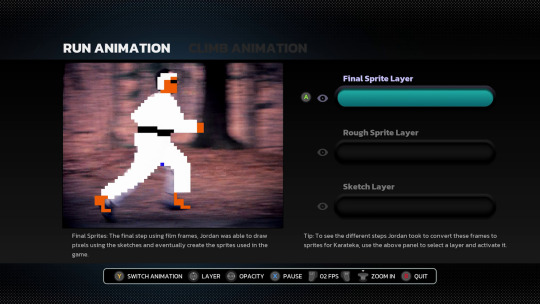
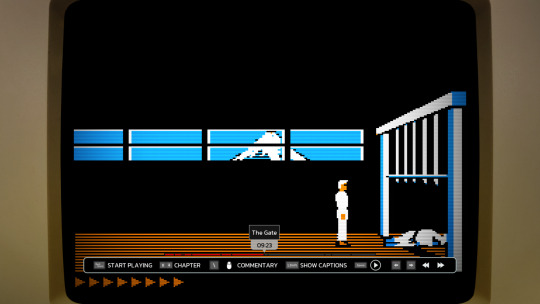
I never played Karateka in the 80s, but as a big fan of Prince of Persia and Jordan Mechner's journals, I was stoked to hear that an interactive documentary about Jordan's prototypical cinematic platformer was in the works by Digital Eclipse.
Released this week, The Making of Karateka on the surface looks like any other game you buy through Steam ($20, Windows-only), GOG, or whichever favorite store or console you prefer (available also for Xbox, PS4/5, Switch). Once the thing loads though, you really get 3 things: a documentary, the original Karateka, and a new remaster.
The documentary part is an audio-visual slideshow retelling Jordan's development story starting with his teenage years pitching his earlier title Deathbounce to the publishing house Brøderbund. It's an interesting look into the iterative process, seen through correspondence letters, journal entries, and many playable builds at various stages of completion. After we reach the eventual rejection of that title, Jordan comes back with a prototype of a visual-narrative experience unseen on home computers. We get to follow Karateka's full life cycle from pre- to post-production, ending with the conception of its sequel (which eventually turned into Prince of Persia). It's a real treasure trove! Fellow pixel artists will appreciate the many graph-paper sketches and interactive overlays of final game sprites compared to rotoscoped outlines and filmed footage. There are also video segments, from a comprehensive breakdown of the music to interviews with other developers reflecting on the impact Jordan's games had on their careers. You'll even encounter a fan letter signed by the one and only "John Romero, Disciple of the Great Jordan and worshipper of the Magnificent Mechner!" (I kid you not, you can't make this stuff up).
Perhaps just as crucial for an interactive documentary like this, you can launch any of the floppy disks in the emulator, trying out various iterations and ports of Karateka.

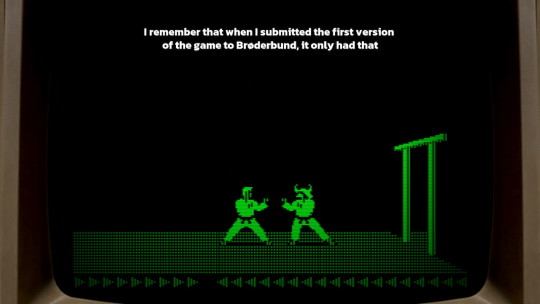
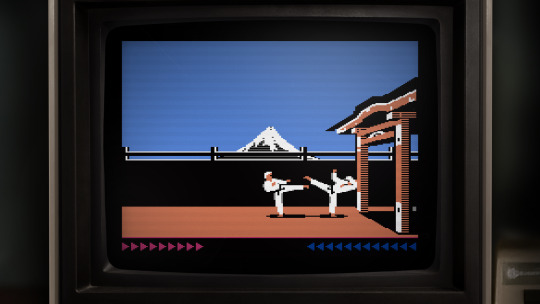
The emulation is fantastic and lets you fiddle with display settings (monochrome or color display, scanlines, pixel perfect or zoomed) as well as enhance the frame rate. You can even rewind the many deaths you will face if you've never played the game before (like me). If you spend some more time obsessing over the weird artifacts of the Apple II hi-res graphics, you might even go down the rabbit hole of realizing that on the Apple II you didn't really paint colors as much as you used different monochrome dithering patterns that the graphics display would then turn into 4 different hues. A fascinating learning experience if you include some of your own research online!
youtube
Add to this the Commodore 64 and the Atari 8-bit versions to compare how the graphics got adapted across the earlier ports and you have a nice way to relieve the mid-80s with a bit of help from modern emulation (I did beat the C64 version without rewinding though!). I'd love to see more art from the other remakes, especially the 16-bit Atari ST port, but I understand their decision to omit playable versions of those due to the lower quality on the gameplay side of the translations.
This brings us to the final part of the package, the modern remaster. Unlike the 2012 complete reimagining of the game (with 3D graphics and all), Digital Eclipse approached the remake as the ultimate port of the original to an imaginary system along the lines of a 90s VGA PC.

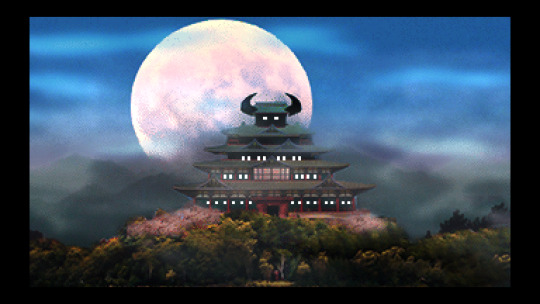


It's well done. Some of the fully-redrawn scenes are a bit overpainted for my taste (I'd prefer a pixel art rendition of the castle than a blurry photographic collage, although there were many games in the 90s that did take this approach), but the in-game graphics are really in style, including the smooth animations that are like one would imagine granted a beefier CPU. It's also a sort of director's cut with previously unseen scenes added, in particular, the battle with the leopard as a clever action-puzzle in the middle. The AI is unfortunately even less challenging than Jordan's implementation. As great as the 6-move fighting system could have been, you yet again resort to simply kicking away opponents as they tirelessly crawl into your range. There isn't even the nuance from the original where you were the one who had to approach some enemies with skilled timing. On the other hand, you now have optional goals and achievements that make the repetitive/easy combat work in your favor (stringing various combos, beating opponents or the level under a time limit …). As the Digital Eclipse president Mike Mika admits at the end of the welcome commentary mode, they didn't manage to achieve their perfect port, but they did come close.
In conclusion, I thoroughly enjoyed playing both the original as well as the remake and while the combat system lacks any sort of depth beneath its stunning animations, Karateka is instead a monumental experience for its presentation. Big characters with personality and realistic motion are displayed through cinematic camera cuts and story vignettes (3 years before Ron Gilbert came up with the word "cutscene"). There are details like animating the unfortunate falling off the cliff at the start of the game, or respectfully bowing to the first guard as they bow in return. Jordan's creative work is precious and worth the attention this release gifts it.
I highly recommend The Making of Karateka to all retro gamers and/or game developers for its immersive documentation which provides an experience that goes beyond the usual video documentaries. It's interactive—just like the subject it's talking about—something I want to see more in the future. And if the $20 by any chance seems high to you, consider that the original retailed at $35 (and that was in 1984 dollars).
youtube
77 notes
·
View notes
Note
ok please tell us about the tandy-memorex vis :D
OKAY the Tandy Memorex Video Information System is a hilarious console that Tandy/Radio Shack came up with in 1992.
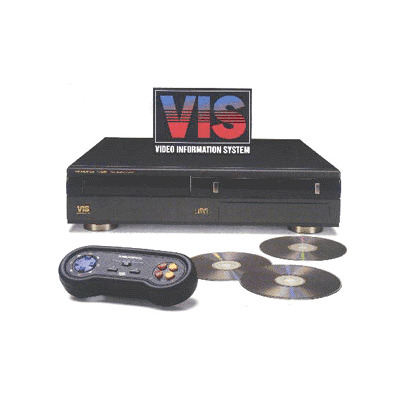
It's called the Tandy-Memorex VIS partially to distance itself from Tandy, but Memorex was owned by Tandy at the time, and this is entirely their fault. Back in 1992, the CD-ROM was the NEW HOT THING and everyone wanted to get in on that. Arguably every console that tried failed to some degree or another, until the Sony Playstation in 1994. But the VIS failed spectacularly hard, selling something like 11,000 units, and Radio Shack was nearly giving them away towards the short lifespan of the console (1992-1994).
It got about 20 games, and another 24 releases that could charitably be called "multimedia products". Things like encyclopedias, photo albums on assorted issues, and spoken-illustrated-book things with minimal animation. Of those 20 games, many of them were edutainment games, things like word puzzles, math games, drawing tools along the lines of kid-pix (on a console with no way to save pictures or print them out, so... yeah).
On top of this, it cost 699$. IN NINETEEN NINETY FUCKING TWO. Plug that into an inflation calculator and it comes out at about one and a half thousand dollars, for a console with barely any games and the ones that it did come with are designed for the little kiddies. This thing never had a market.
But here's the thing that makes it so memorable to me: While the games available for it were not interesting, and it's just another example of a failed CD-ROM console alongside the endless failed or barely-survived ones that littered the early-90s... (Every played a CD-i, 3DO, NeoGeo CD, PC-FX, FX Towns Marty, LaserActive, Commodore CD-TV or Amiga CD32? How about one of the add-ons, the Sega CD, TurboGrafx-CD, or Atari Jaguar CD? Hell, this is what the Nintendo Playstation was supposed to be, before that deal went sideways and it became two separate consoles)
The thing is that technologically the VIS is super unique because it's an idea that wouldn't really be repeated until 2001, nearly a decade later: The VIS is a console that's a computer.
Yeah, I know, all consoles are computers (except maybe arguably some early pong units), but I mean like a desktop PC. The Tandy-Memorex VIS is an IBM PC clone running Windows!
(EDIT: Accidentally submitted too early)
It's a modular windows, a sort of embedded-windows that only runs off a ROM chip, but it's still an Intel 286 with a relatively normal VGA card, a megabyte of RAM, and a 1X CD-ROM drive. This thing could basically play a ton of DOS games, it would just be a matter of some basic porting.
And it just never happened. Instead all the games are custom-designed edutainment/multimedia things, and no one ported Duke Nukem or Commander Keen or Kings Quest to it (Actually Sierra did make a test port of Kings Quest 5, but it never came out. Reportedly it was slow as hell)
It could have been a very interesting console that let us play tons of DOS games in the living room in 1992, but Tandy mismanaged it with the ridiculous price and bad policy regarding games releases which meant it never really amounted to anything.
Anyway I've got one in my room right now, and I'm planning on building a CD-ROM emulator for it so I can easily play around with making homebrew with it. I want to port a bunch of DOS games to it and make it reach its potential, like Tandy should have done in 1992.
They already had a successful line of PC compatibles in the Tandy 1000, and the VIS is partially made of advancements they developed for that weird line of computers. If they had leaned into that angle, sold it at a better price, they could have really built something special. So many advanced DOS games (and even more advanced ones made possible by the CD-ROM format) that would blow away anything else in the console market in 1992 could have been VIS releases. Instead we got some (barely-)FMV games and a bunch of sub-par Math Blaster and Reader Rabbit clones on a console that no one wanted to buy because it was too damn expensive.
165 notes
·
View notes
Text
While her husband’s name was the only one on the box—the company crafted a mystique around Scott as a solo adventure-making genius—Alexis contributed to many of the titles Adventure International produced. Some games credit her as co-creator on their title screens, if nowhere else, and one gives her sole billing there: 1979’s Voodoo Castle. A few other women designers had published games by that year, including Carol Shaw at Atari, but Alexis was among the first to receive a visible credit. In a contemporary interview, Scott noted that she built the game “95% on her own” after learning how to use his database system; this also might make her the first nonprogrammer in history to use a domain-specific tool to make a digital game. She dedicated Voodoo Castle “to all moms!” and it featured multiple female characters, including “Medium Maegen,” a hint-dispensing spiritualist named after her daughter—maybe the first woman with dialogue in a video game.
from 50 Years of Text games, discussing Alexis Adams, wife of Scott Adams
I've never played a Scott Adams game. Honestly, I was mostly only familiar with him as an offhand reference, almost a joke, from the old text adventure community.
Back in the time period when I was involved with the yearly IFComp, most games were made with either Inform or TADS (my preference as it was closer to programming languages I was familiar with). There were always a few people who insisted on building their own awkward homebrew engines which lacked the features of the more mature toolsets, and would often be described as "Scott Adams-like", using simple prose and accepting parser commands of only two words at a time, no fluff. At least a few games claimed to be deliberately emulating that style.
Unfamiliar with the name and history, I misunderstood the context and assumed that Scott Adams was some sort of mad auteur, "giftedly bad", deliberately retro or wildly indie, cheerfully releasing games that lacked 'standard' polish and not caring about it because it was fun. I absolutely did not comprehend how old these first games were, nor how important in the history of home computer game sales. And I certainly never heard Alexis' name. Sadly, she's no longer with us.
#game development#text adventure#interactive fiction#scott adams#history#i WANTED to tag this 'invisible women' to talk about the phenomenon of female contributions to art/science achievements being erased#but unfortunately every tag i can think of leads straight into a bunch of unpleasant discourse about something totally different
12 notes
·
View notes
Text
“El ingrediente más importante es levantarte y hacer algo. Muchas personas tienen ideas, pero solo algunas deciden hacer algo hoy. El verdadero emprendedor actúa en lugar de soñar”
Nolan Bushnell

Es un ingeniero, empresario e inventor estadounidense nacido en Cleveland en febrero de 1943.
Junto a Ralph Baer, fue el fundador de Atari, uno de los pioneros de la industria de los videojuegos.
Nació en Clearfield Utah y fue educado como mormón en la Iglesia de Jesucristo De los Santos de los Últimos Días.
De adolescente trabajó en el parque de atracciones Lagoon en donde tuvo por primera vez la impresión del interés de los visitantes por los juegos, situación que desencadenaría muchas de las decisiones comerciales de su vida.
Al terminar su bachillerato en 1961, se matriculó en la Universidad del estado de Utah para cursar ingeniería y empresariales, e incorporados en la Facultad de ingeniería Eléctrica en 1964.
Buschnell fue uno de los pocos estudiantes que jugaron al Spacewar con un ordenador PDP-1, el cual ocupaba una habitación entera.
Nolan compaginaba sus estudios universitarios con trabajos para la Litton Guidance & control Systems y para el departamento de ingeniería industrial de la misma universidad.
Durante las vacaciones de verano Buschnell creó una empresa dedicada a producir y vender carpetas y espacios publicitarios para cuatro universidades, además de vender ejemplares de la Enciclopedia Americana.
Una vez graduado en 1968 inició estudios de postgrado en la Universidad de Stanford. Intentó trabajar en Walt Disney sin éxito.
En 1970, Bushnell propuso a su compañero Ted Dabney y el programador Larry Bryan crear una compañía para desarrollar una versión modificada de Spacewar que denominaron Computer Space, sin embargo, el juego demostró estar demasiado adelantado a su tiempo por lo que se convirtió en un fracaso comercial.
Con la idea de crear un videojuego que pudiera ser jugado por cualquiera, en 1972 Dabney y Nolan formaron Atari, dando a luz un juego parecido al ping-pong creado por Ralph Bauer que denominaron sencillamente PONG, un juego similar perfeccionado por un ingeniero de Atari.
En 1974 Bushnell y Atari crearon una versión de PONG para el entorno doméstico y gracias a un acuerdo de marketing y comercialización con Sears, las ventas despegaron en 1975, sacando en 1977 el Atari 2600 Video Computer System, que revolucionó el mercado de los videojuegos domésticos creando una nueva ola en las consolas de videojuegos.
Ante las necesidades de expansión del videojuego PONG, Bushnell decidió en 1976 vender la compañía Atari a Warner Communications (ahora Time Warner) en 1974 por la suma de 28 millones de dólares pero manteniendo la dirección.
En ese mismo año, Steve Jobs le propuso a Nolan Bushnell invertir cincuenta mil dólares en su compañía a cambio de un tercio del capital social de su recién formada compañía Apple Computer, sin embargo Bushnell rechazó la oferta. Bushnell confiesa mas tarde que solo de recordarlo aún siente ganas de llorar.
Bushnell mas tarde abandona Atari por desacuerdos entre socios en 1979, regresando a Atari en 2010 como miembro del consejo de administración.
Bushnell ha fundado más de una veintena de empresas y fue incluido en el Video Game Hall of Fame por su influencia en este mercado.
En marzo de 2019 fue nombrado Director Ejecutivo y Presidente de Global Gaming Technologies Corp, un holding de la industria de juego que invierte en tecnologías relacionadas con la realidad aumentada, realidad virtual e inteligencia artificial, además de los populares juegos de e-sports.
Bushnell ha creado muchas innovaciones culturales empresariales que se han convertido en normas, que van desde las sesiones únicas de planificación empresarial hasta la vestimenta de trabajo informal.
Se conoce como Ley Bushnell al aforismo “Fáciles de aprender, pero difíciles de dominar” en referencia a los videojuegos.
Fuentes: Wikipedia, forohistorico.coit.es
#estados unidos#citas de reflexion#citas de la vida#ingenieros#notas de vida#nolan bushnell#inventores#atari#computers#video games#games
21 notes
·
View notes
Text
Digital Essay on my Technology Literacy (Class Assignment)
Digital Essay on my Technology Literacy (Class Assignment)
In 1981 the IBM Personal Computer model 5150 was released. My parents bought one for my 11th birthday, thinking it would be a great asset for school. I used it as a glorified typewriter. You had to essentially add the programs yourself, and that was not easy to do. I was too young to understand what all the bells and whistles did, and there were not many. The World Wide Web, or WWW, was not introduced until 1989, my freshman year in college (the first go-round).

My first video gaming system was Atari. This came out in 1977. However, I didn’t get one until I was about 10 years old. To be perfectly honest, I wasn’t a big gamer. I skipped right over the Nintendo era. My cousins and friends had one, but other than Leapfrog and the first Mario Brothers game, it wasn’t my thing. I wasn’t good at Pac-Man either.

I bought my first cellphone in 1992. It was a Nokia. The first phone bill came in at $289. You got something for 1000 minutes free and were charged .30 cents a minute over that. I understand that in 2023, that may not sound like a lot of money, but in 1992, it took an entire paycheck to pay it. I made $7 an hour, and that was a decent salary working at Macy’s flagship store on 34th Street in New York.

My son was born in 1996, and the world of technology opened new doors for me. I bought him a LeapPad to be used as a learning tool for reading and math. He graduated to every gaming system created from an Xbox to Nintendo. I was introduced to the World Wide Web through social media when Facebook became a thing because I had to monitor his use of this platform. By 2008, my son was in the 7th grade, and I allowed him to interact with his friends on Facebook, but his time was limited, and it was conditional upon him accepting my friend request. My acquired sons (I dislike the word step) were older than him, and they kept me in the loop about how social media worked. Facebook was great for me because it was a link to communicating with my family in New York without having to call all the time. It was great for sharing pictures. Social media has taken a turn, and in some ways its great for activism, in other ways, people are very comfortable being contrary and saying things they would say publicly.
My concern with the development of AI is how easily things can be manipulated. AI’s voice generator can create words that do not come out of someone’s mouth. I see the dangers in that with a political leader’s voice. Manipulating photos can be fun. However, it can also be used to lie about where someone is, what they are doing, and who they are doing it with. Technology is changing rapidly. There isn’t much a robot can’t do. From driving a car without human intervention to soon enough, flying an airplane. My question would be, will there be a time when life imitates art, and we are faced with an iRobot catastrophe.
My technical literacy is almost nonexistent beyond the day-to-day life of social media and basic content creation. As a creative writer, storyteller, and activist, I took this class with the hopes that I will be able to better understand the basics of web design and create more enticing visual content when I use TikTok and other platforms to display my work. I am a Global student, so my entire degree has been online. I graduate in May of 2024!
Over the last year, I have learned to use social media sites like LinkedIn to further my writing presence and create an outlet to network with like-minded people. I am a self-published author on Amazon, and I had to learn how to utilize Canva when creating my book "Journal and Manifest with Your Ancestors." So I consider that to be an incredible success since I created this journal completely on my own. I followed someone on YouTube to learn the ins and outs of utilizing KDP Amazon and Canva.
2 notes
·
View notes
Text
Atari 2600 Chronicles 1980 #8 - Checkers
After one of the longest reviews I ever made was posted yesterday, i'm kinda relieved to be talking about something incredibly simple today.
Checkers... ah snap, what's it about again? Circles... a board... oh, *checkers*. That's all this game is. Three AI difficulties, a multiplayer mode for the intrigued, and since it's made by Activision, it's visually surperior to the other board games we've seen on the system.
And it's direct competition, too, actually! This is a rare case where both Atari and Activision had the exact same type of game in development and released in the span of a couple months. I've played both and I can safely say, I prefer this one despite it's lesser amount of content. No need to elaborate much, it's purely cuz of the controls and visuals. I'm pretty basic in that regard.
This is also another one of those games that got me to learn the actual board game, just like with Backgammon, Nim, and some forms of gambling. Bridge, you're next.
The Verdict
Graphics (7): The best out of the board games on 2600. The checker 'men' and 'kings' as they're called are translated well on the screen, and there's no graphical artifacts or flashing colors to speak of. Nothing spectacular in the slightest, I mean whaddya expect, but it's polished and that's all it needed to be.
Sound (3): This game has ONE WHOLE beep that lengthens if the AI makes a move and is shorter when you move your pieces around the board. No fanfare, no siren, no signal that the match is even *over*. All you get is beeps. Lmao. It only avoids a 1 or 2 because the stepping beep fits that of early early computer games.
Fun Factor (6): A perfectly fine way to play the board game of old. It's ever-so-slightly more convenient than playing with the real board as you can reset the board with a flip of the reset switch. The AI is competent enough to give you a run for your money if you're a novice player like yours truly.
Longevity (6): A little less beefy than Atari's offerings. The three difficulties are, according to some comparitive playtests, closer to the midrange of Video Checkers AI. As mentioned, it's solid for the lesser players among us, yet experts are probably better off looking elsewhere. Multiplayer is a nice little option.
In Conclusion

2 notes
·
View notes
Text

USA 1990
#USA1990#VIDEO GAMES & COMPUTER ENTERTAINMENT#BOOKS#IBM#APPLE#AMIGA#ATARIst#MACINTOSH#C64#NES#SEGA GENESIS#SEGA MASTER SYSTEM#TURBOGRAFX#GAMEBOY#ATARI LYNX
23 notes
·
View notes
Text
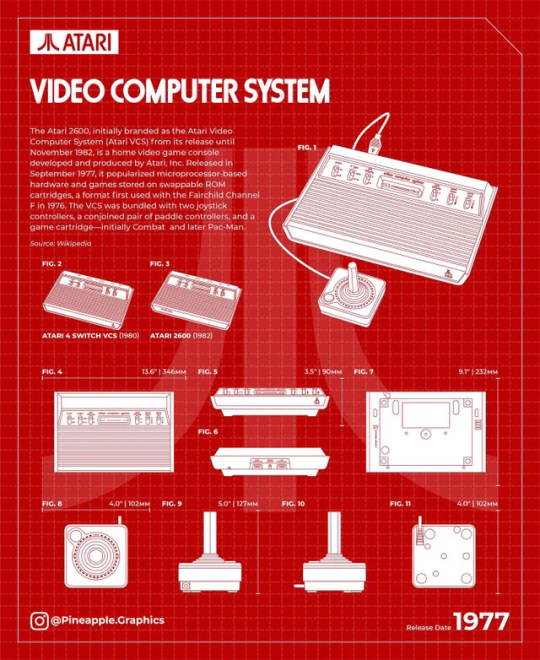
Atari Video Computer System console by Pineapple Graphics
#Atari#Atari 2600#console#joystick#poster art#illustration#graphic design#retro gaming#Pineapple Graphics
35 notes
·
View notes
Text

Box of Atari Video Computer System - VCS 2600
2 notes
·
View notes
Text

Cabal (カベール, Kabēru) is a 1988 arcade shooter video game originally developed by TAD Corporation and published in Japan by Taito, in North America by Fabtek and in Europe by Capcom. In the game, the player controls a commando, viewed from behind, trying to destroy various enemy military bases. The game was innovative for the era, but only a mild success in the arcades, and became better known for its various home conversions.
Cabal has one-player and two-player-simultaneous modes of gameplay. Each player assumes the role of an unnamed commando trying to destroy several enemy military bases. There are 5 stages with four screens each. The player starts with a stock of three lives and uses a gun with limitless ammunition and a fixed number of grenades to fend off enemy troops and attack the base. The commando is seen from behind and starts behind a protective wall which can be damaged and shattered by enemy fire. To stay alive, the player needs to avoid enemy bullets by running left or right, hiding behind cover, or using a dodge-roll. An enemy gauge at the bottom of the screen depletes as foes are destroyed and certain structures (which collapse rather than shatter) are brought down. When the enemy gauge is emptied, the level is successfully completed, all of the remaining buildings onscreen collapse, and the player progresses to the next stage. If a player is killed, he is immediately revived at the cost of one life or the game ends if they have no lives remaining. Boss fights, however, restart from the beginning if the only remaining player dies.
From time to time, power-ups are released from objects destroyed onscreen. Some power-ups give special weapons such as an extremely fast-firing machine gun or an automatic shotgun with a lower firing rate and larger area of effect. Others grant extra grenades or additional points.
The arcade cabinet is a standard upright cabinet. Each player uses a trackball to move their character from side to side and move the crosshairs about the screen. On later board revisions, a joystick was installed instead with an optional sub-PCB for use with a trackball. With a trackball, dodge-rolling is done by pushing the trackball to maximum speed.
Cabal was somewhat innovative in that it featured a 3D perspective in which the player character was situated in the foreground with an over-the-shoulder camera view, similar to modern third-person shooters. Players cannot move the character while firing (holding down the fire button gives players control of the aiming cursor), and when moving the character to avoid incoming bullets, the aiming cursor moves along in tandem. This creates the need for a careful balance between offensive and defensive tactics, separating Cabal from run-and-gun shooters which relied more on reflexes. Advanced gameplay involves destructible asset management in balancing dodging (which gets riskier as the number of enemy projectiles on screen increases) with the safer alternative of taking cover behind a protective but limited durability wall.
Cabal was ported to several home computers of the era, including the DOS computers, Amstrad CPC, Commodore 64, ZX Spectrum, Atari ST and Amiga. It was also ported to the Nintendo Entertainment System console by Rare. A version for the Atari Lynx was previewed and even slated to be published in April 1992, but it was never released by Fabtek.
When converting the game to the Nintendo Entertainment System, Rare were given a Cabal cabinet but did not have access to the game's source code, so they had to play the game over and over and redraw the graphics from memory. To accommodate the many layers and sprites of the arcade game, programmer Anthony Ball used a common coding trick: swapping sprites from left to right every other frame. This has the negative side effect of causing the sprites to flicker when they reach the console's limit of eight per line, but Ball, like many programmers of the era, found this an acceptable trade-off for including all the game's content, and in a 2016 interview he said he is happy with the quality of the conversion.
2 notes
·
View notes
Text
The Evolution of Video Clip Games: From Pixels to Virtual Truth
""
Intro: Video video games have come a lengthy means because their humble starts. From simple pixelated graphics to immersive online reality experiences, the evolution of computer game has actually been a remarkable trip. In this blog site message, we will explore the interesting background of video clip games, checking out just how they have progressed over the years and exactly how they continue to shape the entertainment industry.Paragraph 1: The birth of computer game can be traced back to the 1950s as well as 1960s when researchers and designers started trying out computer system innovation. The very first video clip game," Tennis for Two,"was created by physicist William Higinbotham in 1958. It was a basic game that made use of an oscilloscope as a display screen and enabled two players to contend against each various other in a game of online tennis.Since then, computer game have undertaken many improvements in technology, graphics, as well as gameplay. The 1970s saw the increase of gallery games like"Pong"as well as "Area Invaders,"which changed the pc gaming market and sparked an extensive interest in gaming. The introduction of home gaming consoles in the 1980s, such as the Atari 2600 as well as the Nintendo Enjoyment System (NES ), further promoted video clip games and made them easily accessible to a wider audience.Paragraph 2: The 1990s marked a considerable pivotal moment for computer game, with the development of 3D graphics and also extra advanced gameplay technicians. Games like"Super Mario 64"as well as"Burial place Raider"introduced players to immersive 3D settings, enabling them to explore digital globes like never ever previously. The late 1990s likewise saw the introduction of online gaming, with the launch of video games like "Quake "and"Diablo,"which allowed players to connect as well as complete against each various other over the internet.In recent years, computer game have remained to press the borders of modern technology as well as innovation. The arrival of digital truth(VIRTUAL REALITY)has actually brought an entire new degree of immersion to video gaming, enabling players to enter online globes as well as interact with them in means that were previously unthinkable. Gamings like" Citizen Evil 7" and"Beat Saber"have showcased the capacity of virtual reality, offering gamers with intense and unforgettable experiences.In verdict, video games have developed from basic experiments in computer system innovation to facility as well as immersive entertainment experiences. The developments in modern technology and the innovative minds behind the industry have actually constantly pressed the boundaries of
Read more here https://forcegame.pl/?p=46

2 notes
·
View notes
Text
Predicting AGI Within 35 Months and the Capabilities of ChatGPT4
Dr Alan D. Thompson is a world expert in artificial intelligence (AI), specializing in the augmentation of human intelligence, and advancing the evolution of ‘integrated AI’. He is predicting Artificial General Intelligence will arrive in about 35 months.
Alan provides AI consulting and advisory to intergovernmental organizations including member states of the United Nations, Non-Aligned Movement (NAM), European Union, and the Commonwealth.
His AGI page is tracking specific capabilities and the next three major milestones to his definition of 100% AGI. This would not be superintelligence but a breakthrough to ultra-rapid advances.
39%: In May 2022, DeepMind Gato is the first generalist agent, that can “play Atari, caption images, chat, stack blocks with a real robot arm, and much more”. Alan has a video about Gato.
41%: In February 2023, Microsoft bound ChatGPT to robotics.
Next milestones
– Around 50%: HHH: Helpful, honest, harmless as articulated by Anthropic, with a focus on groundedness and truthfulness.
– Around 60%: Physical embodiment. The AI is autonomous, and can move and manipulate (as shown by Google Robots in Apr/2022, or more thoroughly in Tesla Optimus designs or similar).
– Around 80%: Passes Steve Wozniak’s test of AGI: can walk into a strange house, navigate available tools, and make a cup of coffee from scratch (video with timecode).
NOTE: He is predicting the success of Teslabot within 35 months.








OpenAI is offering a paid developer chat model chat system for 32000 word answers. It is projected that the next widely available version, ChatGPT-4, will provide answers up to about 22,000 words.
Research papers that have calculated the scaling of large language models forecasts GPT4 should have 20X GPT3 compute and have 10X parameters. GPT 5 should have 10X-20X of GPT4 compute in 2025. GPT5 will have 200-400X compute of GPT3 and 100X parameters of GPT3.


Brian Wang is a Futurist Thought Leader and a popular Science blogger with 1 million readers per month. His blog Nextbigfuture.com is ranked #1 Science News Blog. It covers many disruptive technology and trends including Space, Robotics, Artificial Intelligence, Medicine, Anti-aging Biotechnology, and Nanotechnology.
Known for identifying cutting edge technologies, he is currently a Co-Founder of a startup and fundraiser for high potential early-stage companies. He is the Head of Research for Allocations for deep technology investments and an Angel Investor at Space Angels.
A frequent speaker at corporations, he has been a TEDx speaker, a Singularity University speaker and guest at numerous interviews for radio and podcasts. He is open to public speaking and advising engagements.
2 notes
·
View notes